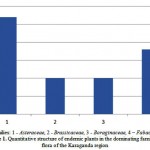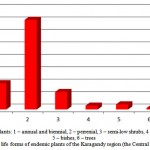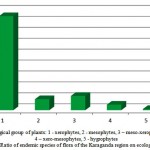Manuscript accepted on : 30 November 2016
Published online on: --
Plagiarism Check: Yes
Evaluation of Specific Diversity of Endemic Plants of Karagandy Region’s Flora
Margarita Yu. Ishmuratova, Saltanat U. Tleukenova, Alexandra Sh. Dodonova, Helena A. Gavrilkova and Almagul K. Auelbekova
Karagandy State University named after academician Ye. A. Buketov, University street, 28, Karaganda, 100028, Kazakhstan.
DOI : http://dx.doi.org/10.13005/bbra/2365
ABSTRACT: The assessment of modern specific structure of endemic plants of flora of the Karaganda region (the Central Kazakhstan) is carried out. The general structure of endemic plants makes 116 species from 57 genes and 21 families. The greatest number of species is concentrated in families Asteraceae, Brassicaceae, Boraginaceae and Fabaceae. The dominating genes are the following: Artemisia, Lappula, Silene, Astragalus, Zygophyllum. The analysis of vital forms has allowed to reveal that the greatest number of species is concentrated among grassy perennials – 73 plants, second position is occupied by annual and biennial plants (21 species), the third positions – by semi-low shrubs (14 species). The last place belongs to trees – 1 species. On ecological groups the greatest number of plants is carried to group of xerophytes - 87 species, on the second place are meso-xerophytes - 13 species, on the third position is mesophytes with 10 species, the smallest number of species is concentrated in group of hygrophytes – 1 plant.
KEYWORDS: endemic plants; flora; Karagandy region; the Central Kazakhstan; life form; ecological group; spreading
Download this article as:| Copy the following to cite this article: Ishmuratova M. Y, Tleukenova S. U, Dodonova A. S, Gavrilkova H. A, Auelbekova A. K. Evaluation of Specific Diversity of Endemic Plants of Karagandy Region’s Flora. Biosci Biotech Res Asia 2016;13(4). |
| Copy the following to cite this URL: Ishmuratova M. Y, Tleukenova S. U, Dodonova A. S, Gavrilkova H. A, Auelbekova A. K. Evaluation of Specific Diversity of Endemic Plants of Karagandy Region’s Flora. Biosci Biotech Res Asia 2016;13(4). Available from: https://www.biotech-asia.org/?p=17237 |
Introduction
Emphasizing the importance of a problem of preservation of a biodiversity it should be noted that Kazakhstan is located in the center of Eurasia with the square taking the ninth place in the world and has almost all types of the landscapes existing on the globe. Such variety of landscapes, and also the existence of the seas and lakes define the richest variety of animals and flora of Kazakhstan. As stability of the biosphere directly depends on wealth and a variety of its components, preservation of a plant and animal life of Kazakhstan is very important for ecological stability not only in Eurasia, but also for the biosphere in general. Extensiveness of the territory of Kazakhstan and specifics of his nature define a big variety and complexity of internal interrelations of its components in complexes of natural landscapes, their zone and zone structure. Kazakhstan on a variety of bio-resources, quantity of raw and trade stocks of a plant and animal life occupies the first place among the states of Central Asia – the Republics of the Commonwealth of Independent States.
For the last century there have been many changes on the territory of the country, the cover, landscapes, vegetable are changed in many regions, ecosystems are degraded.
In Kazakhstan about 14 % of flora belongs to endemic species [1, 2], among them there are many relict plants. Endemic plants, as a rule, are the most vulnerable as they have small natural reserves and narrow areas of spreading. So, at the territory of Kazakhstan are more than 700 endemics among them on the territory of the Central and Northern Kazakhstan are growing more than 70 species; 37 plants need protection and further studying.
Investigations on preservation of rare, endangered and endemic species plants in the nature and culture are presented across Kazakhstan [3-7]. Although they have fragmentary character, are more directed to introductive researches. Practically there are no data on morphology of many endemics in nature, on structure of populations, number, features of reproduction and ontogenesis.
The purpose of the present research was the studying of the distribution and specific structure of endemic plants of the Karaganda region’s flora (the Central Kazakhstan).
Methodology
Objects of researches were natural populations of endemic plants of flora of the Central Kazakhstan.
The preliminary analysis of a specific variety and distribution of endemic species at the territory of the Karaganda region was carried out on the basis of literary data [8-19], the analysis of the herbarium materials (herbaria funds of JSC International Research and Productive Holding “Phytochemistry”, Karaganda State University named after academician Ye.A. Buketov, Zhezkazgan University named after O.A. Baykonurov, Zhezkazgan Botanical Garden, Institute of Botany and Phytointroduction, Buyratau State National Natural Park, specification specific structure and areas – by results of own field inspections.
Field researches are conducted during the vegetative periods of 2012-2015 on certain areas of the Karaganda region.
Definition of plants and allocation of endemics was carried out on “Flora of Kazakhstan” [2], “Determinant of plants of Karkaraly national park” [20], determinant of Brassicaceae family [21]. Names and systematization of species are provided by a taxon according to S.K. Cherepanov reference book [22].
For the studied species of plants vital forms and ecological group are noted. Vital forms revealed according to I.G. Serebryakov’s technique [23]. Allocation of departments is based on structure of elevated axes (wood, semi-wood and grassy plants), types – on relative longevity of plants in general – one – two-and long-term. Ecological groups are allocated in relation to conditions of moistening [24].
Results and discussion
The territory of the Central Kazakhstan of the Karaganda region is located within a continental West Siberian steppe zone and occupies the median position in the republic, bordering with Akmola and Pavlodar regions in the south, with Kustanay oblast in north-west, in the east with East Kazakhstan oblast, in the south – with Zhambyl and Southern Kazakhstan, in the southwest – Kyzyl-Orda oblast. The area of the region makes 428 thousand square km. The territory is extended from the North to the south on 1300 km, from the East to the west on 700 km [25].
In the territory of the Central Kazakhstan the following floristic districts are located: Western low hills, East low hills, Ulytau, Karkaraly, Betpakdala [2].
Negative sides of a geographical position of the Karaganda region [25, 26] are expressed in dryness of climate, a low rainfall (because of equal to remoteness from all four oceans). The general and typical sign for climate of the Republic and, in particular, the Karaganda region is the continental mode of air temperature of which big contrast, sharp seasonal and inter-annual fluctuations is characteristic.
The preliminary analysis of flora of the Karaganda region (the Central Kazakhstan) has shown growth of 101 species of the endemic plants relating to 50 genes and 18 families [2, 16].
On the basis of own field researches, literary sources and the herbarium materials we have carried out forwarding departures which have allowed to specify distribution of species across the territory of the Karaganda region and to make the list of endemic species of the Central Kazakhstan (table 1).
Table 1: Taxonomic composition of endemic plant species of Karagandy region
| Family | Number of genera, pieces | % from total number of endemic genera | Number of species, pieces | % from total number of endemic species |
| Alliaceae | 1 | 1,7 | 2 | 1,7 |
| Apiaceae | 3 | 5,2 | 6 | 5,1 |
| Apocynaceae | 1 | 1,7 | 1 | 0,9 |
| Asteraceae | 16 | 28,1 | 28 | 24,1 |
| Berberidaceae | 1 | 1,7 | 1 | 0,9 |
| Boraginaceae | 4 | 7,0 | 10 | 8,6 |
| Betulaceae | 1 | 1,7 | 1 | 0,9 |
| Brassicaceae | 6 | 10,5 | 10 | 8,6 |
| Caryophyllaceae | 1 | 1,7 | 6 | 5,1 |
| Chenopodiaceae | 3 | 5,2 | 5 | 4,3 |
| Euphorbiaceae | 1 | 1,7 | 4 | 3,5 |
| Fabaceae | 5 | 8,7 | 18 | 15,5 |
| Iridaceae | 1 | 1,7 | 1 | 0,9 |
| Lamiaceae | 3 | 5,2 | 6 | 5,1 |
| Limoniaceae | 1 | 1,7 | 2 | 1,7 |
| Papaveraceae | 1 | 1,7 | 1 | 0,9 |
| Poaceae | 2 | 3,5 | 2 | 1,7 |
| Polygonaceae | 2 | 3,5 | 3 | 2,6 |
| Rosaceae | 2 | 6,5 | 2 | 1,7 |
| Scrophulariaceae | 1 | 1,7 | 2 | 1,7 |
| Zygophyllaceae | 1 | 1,7 | 5 | 4,3 |
| Total: 21 | 57 | 100 | 116 | 100 |
The general specific structure of endemic plants makes 116 species from 57 genes and 21 families. The greatest number of species is concentrated in families Asteraceae, Brassicaceae, Boraginaceae, Fabaceae (figure 1).
 |
Figure 1: Quantitative structure of endemic plants in the dominating families of flora of the Karaganda region |
The largest genes which maintain the greatest number of endemic species of plants are Artemisia (8), Lappula (6), Silene (6), Astragalus (10), Zygophyllum (5). On the basis of the obtained data the conspectus of flora of endemic plants of the Karaganda region is made.
The analysis of vital forms has allowed revealing 6 groups: annual- and biennial plants, perennial plants, semi-low shrubs, semi-bushes, bushes and trees (figure 2).
The greatest number of species is concentrated among grassy perennials plants – 73, the second position is taken to annual and biennial plants (21 species), the third is taken to semi-low shrubs (14 species). The last place belongs to trees – 1 plant.
The analysis of endemic plants on ecological groups in relation to conditions of moistening has allowed revealing 5 groups: xerophytes, mesophytes, hygrophytes, meso-xerophytes and xero-mesophytes. The greatest number of species is carried to group of xerophytes – 87 species, on the second the place of a meso-xerophytes – 13 species, on the third – mesophytes with 10 species (figure 3). The smallest number of species is concentrated in group of hygrophytes – 1.
 |
Figure 2: The life forms of endemic plants of the Karagandy region (the Central Kazakhstan) |
 |
Figure 3: Ratio of endemic species of flora of the Karaganda region on ecological groups |
Following the results of a condition of populations all revealed endemic species have been broken into 3 categories:
1) Widespread plants, well renewing in the seed or vegetative way, are poorly subject to an anthropogenous pressure therefore their state doesn’t demand special measures for protection – 38 species. They are needed regular monitoring of a condition of populations.
Such endemic plants as Medicago trautvetteri, Hyssopus macranthus and Serratula dissecta are carried to them.
2) Plants which extended sporadically, which are moderately renewing in the seed or vegetative way – 62 species. Seed reproduction is not regular. The strengthened anthropogenous pressure because of economic or decorative characteristics of a species is possible. It is necessary to limit economic activity (a cattle pasture, haymaking) in territories with this species, a regular seasonal monitoring of a condition of coenopopulations. Preservation of plant is not only ex situ, but also introduction to culture, introduction to banks of seeds for preservation of genetic potential is desirable.
These are the following endemic plants: Iris haemotophylla, Silene holopetala, Rumex komarovii.
3) Seldom found species of plants – 15 species. Populations badly compete with other species, not regular and weak seed reproduction. Populations tend to reduction of an area and aging. Plants can be exposed to a considerable anthropogenous pressure. It is necessary to forbid economic activity (a cattle pasture, haymaking) in territories with these species; regular seasonal monitoring of a condition of coenopopulations; introduction to culture, introduction to banks of seeds for preservation of genetic potential. Development of a complex of actions for reintroduction of species is necessary. Among this group are Papaver tenellum and Astragalus unijugus.
Conclusion
Thus, the specific structure of endemic species of plants at the territory of the Central Kazakhstan is specified, ranging of plants in vital forms, ecological groups and degree of prevalence is carried out.
Received data can be used for monitoring of environment and development of actions for protection of endemics at the territory of the State National Natural Parks.
Acknowledgments
Researches are executed within the grant project of Committee of Science of Ministry of Education and Science of Kazakhstan “Studying of a current state of populations of endemic plants of Northern and Central Kazakhstan and development of methods of preservation of genetic material” (2015-2017).
References
- Krasnaya Kniga Kazakhstana. Rasteniay [Red Book of Kazakhstan. Plants] [Text]. Astana: Institute Botany and Phytointroduction. 2011.
- Pavlov N. V. Flora Kazakhstana, (Tom 1-9). [Flora of Kazakhstan. Vol. 1-9.] [Text], Alma-Ata, 1956-1966.
- Kokoreva I. I., Otradnyh I. G., Sjedina I. A and Lysenko V. V. Redkie vidy rasteniy Severnogo Tiayn-Shanya [Rare species of plants of Northern Tien-Shan] [Text], Populations, morphology, ontogenesis, renewal. International Journal of Experimental Education. 2015;12:61-62.
- Kotukhov Yu.A., Danilova A.N., Anufriyeva O.A. Sovremennoe sostoyanie populyaziy redkih i izchezayushih rasteniy Vostochnogo Kazakhstana (vol 1) [Current state of populations of rare and disappearing plants of the Eastern Kazakhstan] [Text]. Almaty: Tetris publishing house, 2006.
- Kotukhov Yu.A., Danilova A.N. and Anufriyeva O.A. Sovremennoe sostoyanie populyaziy redkih i izchezayushih rasteniy Vostochnogo Kazakhstana (vol 2) [Current state of populations of rare and disappearing plants of the Eastern Kazakhstan] [Text]. Almaty: Tetris publishing house, 2009.
- Ivlev V.I. Introduksiya redkih i izchezayushih rasteniy v Centralnom Kazakhstane [An introduction of rare and disappearing plants in the Central Kazakhstan] [Text], Experience, assessment, analysis, 2012; Saarbrucken.
- Rasteniya prirodnoy flory Kazakhstana v introdukcii [Plants of natural flora of Kazakhstan in introductions] [Text], Alma-Ata: Gılım, 1990.
- Baymukhambetova Zh.K. Zametki o endemichnykh vidakh Centralnogo Kazakhstana [Notes about endemic views of the Central Kazakhstan] [Text]. Alma-Ata: Botanical materials of a herbarium of Institute of botany of Academy of Science of Kazakh Soviet Socialistic Republic, 1985.
- Kurt A.Kh., Matveev A.N. and Ishmuratova M.Yu. Endemichnii rasteniya gor Ulytau [Endemics of Ulytau’s mountains] [Text]. Novosibirsk: SiʙAK, 2014.
- Anapiyev I.M. Endemichnyi, reliktovie i redkie vidi rasteniy Centralnogo Kazakhstan i ikh zashita [Endemic, relict and rare species of plants of the Central Kazakhstan and their protection] [Text]. Modern problems of ecology in Central Kazakhstan: Proceedings of the National Conference. Karaganda, 1996.
- Ebel A.L. and Kupriyanov A.N. 2013. Zametki o endemichnom rastenii Centralnogo Kazakhstana – Erysimum kazachstanicus Botsch. [The note about an endemic plant of the Central Kazakhstan – Erysimum kazachstanicus Botsch.] [Text]. Systematic notes on materials of the Herbarium of Tomsk university, 107: 15-18.
- 12 Kupriyanov A.N. 2013. Zametki o endemichnom rastenii Centralnogo Kazakhstana – Artemisia hippolyti Butk. [The note about an endemic plant of the Central Kazakhstan – Artemisia hippolyti Butk.] [Text]. Turczaninowia, 16 (4): 12-15.
CrossRef - Ishmuratova M.Yu. and Tleukenova S.U. 2009. O sosudistikh rasteniyakh flory Centralnogo Kazakhstana [About vascular plants of flora of the Central Kazakhstan] [Text]. Herald of Karaganda State University, a series biology, medicine, geography, 4: 9-20.
- Tleukenova S.U. and Ishmuratova M.Yu. 2010. Analyz flory gor Karkaraly [Analysis of flora of mountains of Karkaraly] [Text], Herald of Karaganda State University, a series biology, medicine, geography, 2: 33-39.
- Kupriyanov A.N. and Khrustalyova I.A. Flora gor Becktauata (Centralniy Kazakhstan) [Flora of Bektauat’s mountain (the Central Kazakhstan)] [Text]. Botanical researches of Siberia and Kazakhstan, 10: 25-36.
- Amanov S.B. 2009. [K rasprostraneniyu endemikov na territorii Karagandinskoy oblasty [To distribution of endemics at the territory of the Karaganda region] [Text]. Herald of Karaganda State University, a series biology, geography, medicine, 1 (53): 25-31.
- Kupriyanov A.N. and Korolyuk E.N. 2013. Galatella bectauatense Kupr. – noviy vid zi Centralnogo Kazakhstana [Galatella bectauatense Kupr. – is the new species from the Central Kazakhstan] [Text], Turczaninowia, 3 (16): 16-18.
- Kupriyanov A.N. 2010. Noviy vid Hieracium bectauatensis Kupr. iz Centralnogo Kazakhstana [New species of Hieracium bectauatensis Kupr. from the Central Kazakhstan] [Text]. Systematic notes on Herbarium materials of P.N. Krylov of Tomsk State University, 102: 1-3.
- Kupriyanov A.N. 2010. Noviy vid Hieracium L. (Asteraceae) iz Centralnogo Kazakhstana [ New species of Hieracium L. (Asteraceae) from the Central Kazakhstan] [Text]. Systematic notes on herbarium materials of P. N. Krylov of Tomsk State University, 102: 1-3.
- Kupriyanov A.N., Khrustalyova I.A., Manakov Yu.A. and Adekenov S.M. Opredelitel sosudistykh rasteniy Karkaralisnkogo nazionalnogo parka [Determinant of vascular plants of Karkaraly National Park] [Text]. Kemerovo: Kuzbass Botanical Garden SB RAS IECH, 2009.
- Ebel A.L., Hermann D.A., Kupriyanov A.N. and Khrustalyova I.A. 2014. Obzor semeystva Brassicaceae flory Kazakhskogo melkosopochnika [The review of Brassicaceae family of flora of the Kazakh low-hills] [Text]. Systematic notes on herbarium materials of P. N. Krylov of Tomsk State University, 109: 20-38.
- Czerepanov S.K. Vascular plants of Russia and adjacent states (former USSR) [Text]. Cambridge: CambridgeUniversity Press, 1995.
- Serebryakov I.G. 196. Zhiznennie formy visshikh rasteniy i ikh izuchenie [Vital forms of the higher plants and their studying] [Text]. Field geobotany, 3: 146-205.
- Odum Yu. Ekologiya [Ecology] [Text]. Moscow: Peace, 1986.
- Maksutova P., Dyusekeeva Sh.E. and Kulmaganbetova A.O. Fisicheskaya geografia Karagandinskoy oblasty [Physical geography of the Karaganda region] [Text]. Karaganda: SANAT- Printing, 2005.
- Dzhanaliyeva K.M., Budnikova T.I. and Veselov E.N. Fisicheskaya geografia Respubliki Kazakhstan [Physical geography of the Republic of Kazakhstan]. Almaty: Kazak universiteti, 1998.

This work is licensed under a Creative Commons Attribution 4.0 International License.





